Sustainable Food Plant of the Year 2022
A Double Win for Dennis Group
—and a step toward sustainability
This year, Kerry's expansion on its crumb and coating facility won Food Engineering's "Food Plant of the Year" Award (Division 3) and their "Sustainable Plant of the Year" Award.
Demand | Navigation | Adaptation | Safety | Expansion | Flagship
August 12, 2019. It’s hard to pinpoint exactly when the so-called “chicken wars” started – after all, US chicken consumption per capita has been growing steadily since 1960 – but there’s no doubt that August 12 was an important milestone. It began unassumingly enough, when Popeye’s quietly and without much fanfare introduced their Crispy Fried Chicken Sandwich.
It didn’t stay quiet for long. The sandwich was an instant hit. People waited in long lines…tweeted about it…fought over it. Popeye’s store traffic doubled, each location selling upwards of 1,000 sandwiches daily until they sold out. The chicken craze had officially begun, and soon similar offerings appeared on the menus of fast food retailers big and small, from KFC to Shake Shack to McDonald’s.
But this isn't just a story about chicken. It's about the true unsung heroes of the chicken wars: the seasonings, coatings, and breadcrumbs that make these sandwiches so intensely craveable. After all, what is a chicken sandwich without a flavorful, well-seasoned, crispy exterior?
Achieving the irresistible flavor and texture of these crumbs and meeting the soaring demands of the protein market meant that food producers needed to expand and adapt quickly — without sacrificing the quality of their products or the success of their existing operations.
To find out how one food producer managed this feat and paved the way for future sustainable food production while they were at it, we need to shine a spotlight on the exceptional facility where expert design and engineering brought it all together.
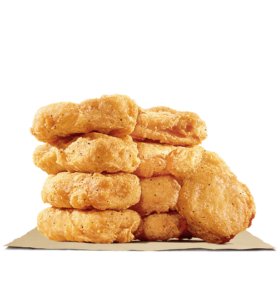
"Achieving the irresistible flavor and texture of these crumbs and meeting soaring demand ...meant that food producers needed to expand and adapt quickly — without sacrificing the quality of their products or the success of their existing operations."
Demand | Navigation | Adaptation | Safety | Expansion | Flagship
As far as food manufacturing facilities are concerned, Kerry's Rome facility is unique.
Rather than a steel structure, the standing-t building is made of precast concrete with cables running through concrete walls, which would require extensive anchoring to counter their extra weight. The building would also require a reshuffling of storage and production spaces to accommodate the new lines.
On top of the unusual building composition shape and functional space arrangements, the facility would be in continuous production. This meant that space on site for equipment receipt and placement would require careful thought and consideration in order to maintain the quality and functionality of the existing processes. In order to overcome this logistical puzzle, the operations, safety, quality and construction teams coordinated extensively to create strategic openings within the building and anticipate issues before they arose.
"...on top of the unusual building shape, the facility would be in continuous production, so equipment receipt and placement needed careful consideration to maintain the existing processes."
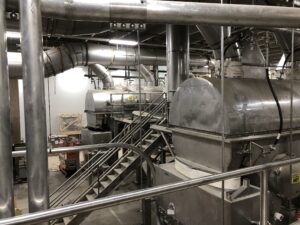
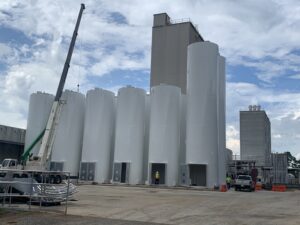
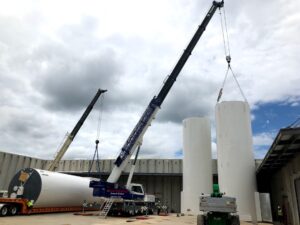
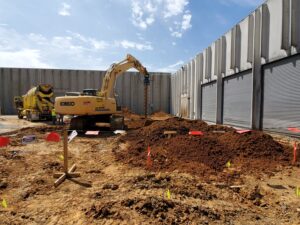
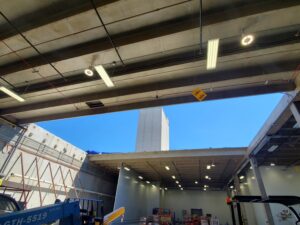
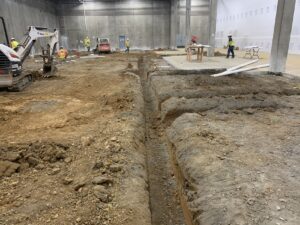
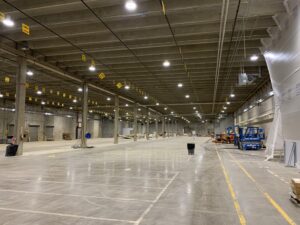
Preparing for New Lines
Preparation for the new lines required extensive demolition and refurbishment. The team had to decommission an existing process located in a six-story tower. This required that the team remove 100 tons of equipment and infrastructure through a series of 10’ x 10’ openings, via a carefully sequenced cutting, loading, and transfer operation. To feed the operational lines, receiving stations for bulk flour deliveries had to be created away from the construction areas, and 25 ft. sections of roof panels adjacent to production lines had to be removed with great care and precision.
Safety
The safety of both the production teams and the integrity of the lines adjacent to the construction areas was critical throughout the operation. In preparation for the upcoming extensive work, the project team created transition zones segregating construction from GMP areas.
Sanitary Design
Refurbishment presented the opportunity to enhance sanitary design details throughout the facility. Taking a holistic approach, the design team evaluated each individual work center, observed employee and product flow, utilities, equipment, materials, and how each of these interacted with one another. Then the design team identified areas for improvement and potential solutions.
Upgrades
The team also sought other ways to increase efficiency and operational space. After assessing the facility's existing infrastructure, they implemented other improvements, such as new IMP walls with coated concrete curbs, stainless steel platforms, and upgrades to compressed air piping, from carbon piping to stainless steel. This increased the facility’s one COP room to four significantly larger rooms and added 26 air handling units, along with 11 dust collection systems to minimize dust egress and clean-up.
Efficient Material Handling
With a plant this large, efficient material handling is critical. In addition to the four existing silos for bulk materials receipt, the new design added twelve new silos. Through automation, the design maximized flexibility for bulk and supersack usage, reducing dependence on handling 50 lb. bags. The entire unloading facility comprises more than 2.5 miles of aluminum pneumatic conveyance piping and features five new unloading stations, each with a maximum 50,000 pound-per-hour capacity.
Automation & Controls
While the scale and throughput of Rome’s new lines are impressive, their automation extends beyond operations. From raw ingredient receipt until the final product is being palletized, data drives every step of the process. Recipe management is administered not at the plant but at the corporate level. The sophisticated and thorough communication process ensures a safer, more consistent, and high-quality product, so the plant can begin the production process with confidence.
Demand | Navigation | Adaptation | Safety | Expansion | Flagship
Construction started in January 2020, just as whispers of COVID-19 were starting to make headlines in the United States.
Anyone who has run a large construction project knows that despite careful planning, there are always going to be surprises, particularly when working within an existing facility. While the team certainly expected some engineering hurdles, no one anticipated a worldwide pandemic just as construction was kicking into high gear. On a project where hundreds of contactors would be working on site together, the Safety, Quality, and Construction teams needed to coordinate their response to this new challenge, and quickly.
To stay abreast of the rapidly changing COVID guidelines, Kerry’s Safety & Quality team implemented safety measures like social distancing, masking, and contact tracing ahead of CDC recommendation.
They also conducted mock contact tracing drills without warning to educate the construction team on how to respond swiftly to positive cases. Throughout the process, the Construction and Safety teams maintained their customary emphasis on job site safety protocols.
The pandemic also sparked innovation. To overcome travel restrictions and keep the Head Office Teams in Ireland connected with the site progress, the teams utilized technology including Virtual glasses, GoPro cameras, and interior and exterior drone footage. With these solutions, the team was able to conduct real-time virtual tours, as well as virtual factory acceptance tests with vendors outside the United States.
Ultimately, their efforts paid off. At the height of construction, more than 350 contractors were on the site together, yet the team experienced little downtime due to COVID-19, aside from a precautionary closing between Christmas and the New Year.
Throughout the duration of the project, 2,000 contractors completed safety orientations, and 10,000 safe work permits were completed, including job safety analysis, hot work permits, and critical lifts. The project, which involved nearly 500,000 contractor work hours, was completed with no recordable injuries.
"...No one anticipated a worldwide pandemic just as construction was kicking into high gear. On a project where hundreds of contactors would be working on site, the team needed to respond to this new challenge, and quickly."

Demand | Navigation | Adaptation | Safety | Expansion | Flagship
Most facilities of this nature have critical control points at the end of the line, but Kerry wanted to go above and beyond industry norms. Both food and employee safety were scrutinized by the cross-functional team to address potential issues and establish in layers of protection and prevention.
Eliminating Foreign Materials
To help eliminate foreign materials from the product stream, the team added screening and magnets at various points throughout the process. Materials are received in three formats: bulk truck, super sack, and 50 lb. bags. After receiving, product goes through sifting, screening, and metal detection with magnets used at each infeed. All products run through magnets and metal detection and undergo an x-ray examination after bagging.
Food Defense & Documentation
Cameras have also been installed in any area where there is the potential for open contact with the product. These cameras are strategically placed with viewing screens throughout the process or via a central location in the plant. If an investigation needs to be conducted, full documentation is readily available. Rooms are washdown ready, and equipment was designed and installed with cleanability in mind.
Capturing Real-Time Data
End-to-end traceability was another critical food safety feature, so the facility uses Rockwell’s FactoryTalk Historian to capture 5,735 data points. This provides real-time and historic process data trends, alarm and event monitoring, down-time, and manufacturing KPI tracking, as well as asset management, change management, and access controls data which can be used for forecasting and productivity.
Modeling Safety & Ergonomics
3D modeling helped the team design for employee safety. Placements of platforms and bollards were examined and tweaked via a model which resulted in design improvements for better safety and access. Design tweaks included changes to mixer loading areas with new platforms and revised layouts to improve ergonomics, allowing gravity to do the hard work. Quality procedures for sampling of product were reviewed. Thanks to the input from quality, new access ports were designed into process equipment and an additional three-levels of suspended structural platforms were built inside the 28’ high room to facilitate easy, safe access around dryers and mills regularly. Forklift traffic in the narrow section of the building was also reduced by more than 50% through the addition of the overhead conveyance system.
Demand | Navigation | Adaptation | Safety | Expansion | Flagship
To say this expansion increased capacity is an understatement, considering it added a whopping 30% more capacity across Kerry’s network. To put it in perspective, the Rome facility has the capacity to produce enough coating for approximately 70 billion chicken nuggets annually.
The expansion project in Rome, GA gave Kerry an opportunity to assess and rationalize operations not only in that facility, but across the entire network of five facilities in North America dedicated to coatings and breadcrumbs. At the time, four facilities were running a combined 1,000+ SKUs, some of which were reassigned to new facilities for greater efficiency.
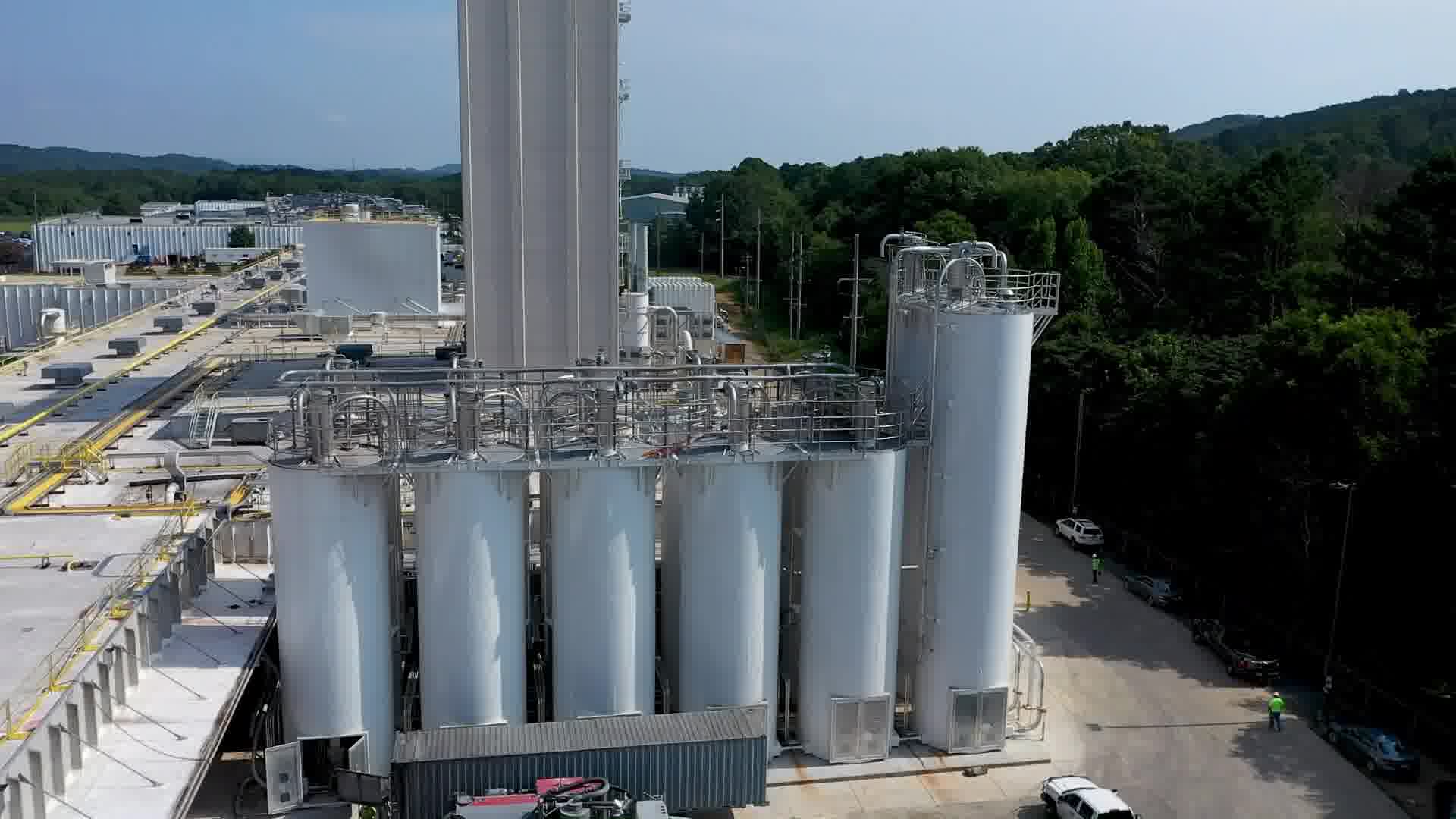
Sustainable Design
In 2020, Kerry announced an ambition to reach over two billion people with sustainable nutrition solutions by 2030 as part of their Beyond the Horizon sustainability program. Kerry is committed to creating products that are better for people, society, and the planet.
Each of these three pillars informed Project Bulldog’s design. To make the product better for people across a range of metrics, systems were put in place to mitigate food and human safety risks and deliver consistent quality and nutrition. With employee safety a key consideration, several design changes improved ergonomics. New employee amenity areas were also added, consistent with Kerry’s hygienic zoning requirements. But it’s in the third pillar – planet – where this facility excels. See right for the details.
When it comes to making products that are better for society, community development and employee wellbeing are key topics. Kerry worked closely with regional leaders to extend job recruitment and training opportunities and collaborated with the State of Georgia and local and regional economic development to create training documentation via the state’s Quick Start program.
100% Renewable electricity
The facility uses 100% renewable electricity as well as energy-efficient design which is estimated to have a 34% reduction in scope 1 and 2 carbon emissions versus an industry benchmark1.
50% Materials Sourced Locally
50 of all raw materials are sourced within 150 miles of the facility, and 95 of all raw materials are sourced within North America, which helps reduce scope 3 carbon emissions through the supply chain.
25% Freight Reduction
The addition of extra bulk storage capabilities yielded a 25% reduction in freight to the site, further reducing carbon emissions through the supply chain
8% Overall carbon reduction
The energy efficiency and strategic sourcing of materials — including the addition of bulk storage — resulted in 25% less freight to the site, and an overall 8% reduction in carbon emissions per ton of finished goods1
Carbon offset equal to 43 acres of forest
The carbon off-set by sourcing renewable electricity alone in 2021 is equal to rescuing roughly 43 acres of US forests preserved from converstion to cropland in one year2. This is equivalent to the 32 field of the entire National Football League (NFL).
The team designed this facility with zero waste to landfill (ZWTLF) in mind, constructing central recycling and bailing facility within the plant itself to optimize waste streams and maximize recycling. Supersacks, cardboard, and plastic are recycled, while product that falls out of specification is collected for animal feed. Balers and compactors prepare each of the different waste streams for receipt. The remaining refuse will be sent to incineration with energy recovery starting in 2022, making the facility ZWTLF.
Recipe Management
As part of the infrastructure optimization, Kerry centralized recipe management at the corporate level through SAP – a first for us. This means that anytime a recipe is modified, or a new recipe is made, a process order can be executed at any of Kerry’s facilities and ingredients are automatically pulled to the line without operator intervention. Using secure API connections to and from the SAP platform, Dennis Group’s controls team linked the Rockwell Automation FactoryTalk Batch distributed system in Rome to the central recipe management system, eliminating the need to create plant-level recipes and allowing for production order scheduling days or weeks in advance.
Usage and batch event data is reported back to SAP for inventory control purposes. The system is set up to be flexible so that the recipe can dictate not just quantities, but the order of addition. Information from SAP automates the entire line from mixing to packaging, reducing operator error. The result is improved quality and consistency, as well as speed and ease of implementation for new recipes.
Demand | Navigation | Adaptation | Safety | Expansion | Flagship
Kerry was determined to deliver a best-in-class facility to cater to a growing client base. The sanitary design elements in this facility go above and beyond what one would expect to see at most comparable facilities.
A new interactive 3D tour was created to give customers the experience of walking through the facility even when travel restrictions or budgets wouldn’t allow them to be physically present. The tour required three full days of shooting 360-degree video in every area of the plant. The team used a combination of RC cars for roving footage, a hand-held camera, and a drone for aerials inside the building.
Kerry has worked hard to become a total solutions provider for their core customer base of meat processors and producers of breaded or battered foods. The growing plant-based protein sector is another key target. Customizing coatings with seasonings, flavors, and tonalities from Kerry’s taste portfolio allows customers to offer specific taste profiles, whether they’re creating a trademark flavor, a new, limited-edition one, or everything in between. Additionally, Kerry’s leading smoke and grill portfolio and food preservation technologies can help clients solve virtually any meat or plant-based meat challenge.
This $125 million facility expansion – delivering on all key business objectives while meeting schedule and budget – is a testament to design, sustainability, and to the power of teamwork. As Kerry’s flagship facility, it is future-proofing the company’s ability to deliver sustainable, high-quality, safe ingredients to a rapidly growing customer base. Kerry’s rapid evolution over their 50 year history demonstrates how they continue to solve for tomorrow.
The Rome facility now has the flexibility to deliver every product in Kerry’s portfolio, from pre-dust to batter, blended, breadcrumb (Japanese and American), and cracker meal. Combine Rome’s production capacity with Kerry’s other manufacturing capabilities for flavors and food protection and preservations, and you have a company well-poised to respond to long-term consumer trends and customer demand. Because you never know what will set off the next great food war.
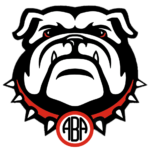
Meet the Project Bulldog team
Architecture
Mariana Abdelmesseih • Matthew Bernabe • Grant Farnsworth • Severn Goodwin • John Landry • Kyle Nadeau • Odaly Plancarte • Tyler Rowley • Anne Slick • Christopher White
Civil
Daniel Burger • James Walton
Construction Managers
Jason Cavanee • Robert Garza • Garrett Greenwood • Deborah Romine • Blake Velez
Controls
Debra Bavaro • Christopher Bryant • Katia Checkwicz • Nicholas Farmer • Sean Hoffman • Michael Kuurstra • Philip Lailer • Kathryn Miller • Diego Moreira • Jaykumar Patel • Chase Quintana • Brandon Redder • Timothy Skinner • Trongkhoi Vu • Caleb Whited • Ryan Yun
Corporate
Iwona Ruszczyk
Electrical
Tyler Czupryk • Martin Majkowski • Richard Sanly
Mechanical
Jonathan Baczek • Kevin Fuller • Jackson Klesse • Matthew Sychtysz
Bennett Bartmess • Levi Carlton • Tom Clark • Jared D'Amico • Jason Hodge • Caleb Holizna • Matthew Sargent • Jason Woods
Kori Alejandro • Bryanna Arpin • Sydney Borcherding • Graham Cabrey • Casey Colonna • Gerald Corbin • Casey D'Amato • Michael Epperson • Andrea Ford • Nicholas Foster • Justin Goveas • Jonas Grayson • Christopher Grogan • George Mckella • Alexander Morris • David Musto • Mark Overdevest • Tyrone Peterson • Valentina Pietrzak • Alan Rotatori • Stephane Simard • Christopher Tan • Uria Tollman • Alek Wereszczak • Paulina Ying
Allison Massie • Amanda Mistalski • Gary Mistalski • Steven Murray • Eshofune Ogene • Christopher Siart • Tabatha Simkewicz
Jacob Farina • Robb Francetich • Todd Miller
Yuchen Zhou





